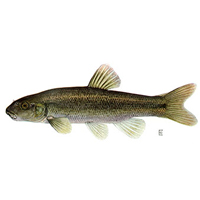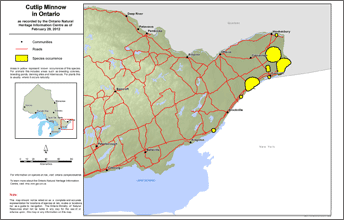Cutlip minnow
Scientific name: Exoglossum maxillingua

Cover photo credit: New York State Department of Environmental Conservation
Status
Threatened
“Threatened” means the species lives in the wild in Ontario, is not endangered, but is likely to become endangered if steps are not taken to address factors threatening it.
Date added to the Species at Risk in Ontario List
The Cutlip Minnow was already assessed as threatened when the Endangered Species Act took effect in 2008. A reassessment in 2014 confirmed this status.
Read the Report (PDF)
What it looks like
The Cutlip Minnow reaches 14 centimetres in length. It has a rounded or slightly pointed snout with a downward facing mouth, resembling an overbite. The lower lip has three lobes and appears to be indented in the middle, which is how the species earned its unusual name. The body is olive, brassy or brown-coloured with a whitish belly. Most of the fins are pale or yellowish except the tail and dorsal fins, which may be a red-brown colour.
Where it lives
In Ontario, the Cutlip Minnow lives in warmer rivers and creeks with clear, slow-moving water, and a rocky or gravel bottom. The males dig nests in the gravel where the females lay their eggs. Nests are often found under banks, logs, or around large rocks. The adult feeds on the river bottom and eats aquatic insects.
Where it’s been found in Ontario
In Canada, the Cutlip Minnow is found in Ontario and Quebec. Since the 1930s, this species has been recorded at 12 sites in southeast Ontario. However, the most recent surveys have found the Cutlip Minnow at only a few sites in the province.
View a larger version of this map (PDF)
What threatens it
The main threat to the Cutlip Minnow is habitat degradation. This species likes clean, clear water and does not do well in rivers that are muddy or polluted. Streams can become muddy due to soil washing into the water from nearby urban and agricultural areas. Competition for nest sites with other fish, such as the Common Shiner (Luxilus cornutus), may also be a problem.
Action we are taking
Threatened species and their general habitat are automatically protected.
Recovery strategy
A recovery strategy advises the ministry on ways to ensure healthy numbers of the species return to Ontario.
Read the recovery strategy (May 31, 2013).
Government response statement
A government response statement outlines the actions the government intends to take or support to help recover the species.
Read the government response statement (March 14, 2014).
Review of progress
A review of progress made toward protecting and recovering a species is required no later than the time specified in the species’ government response statement, or not later than five years after the government response statement is published if no time is specified.
Read the report on progress towards the protection and recovery of 16 species at risk, including Cutlip minnow (Exoglossum maxillingua) (2019).
Habitat protection
General habitat protection - June 30, 2013
What you can do
Report a sighting
- Report a sighting of an endangered animal or plant to the Natural Heritage Information Centre. Photographs with specific locations or mapping coordinates are always helpful.
Volunteer
- Volunteer with your local nature club or provincial park to participate in surveys or stewardship work focused on species at risk.
Be a good steward
- Private land owners have a very important role to play in species recovery. If you find Cutlip Minnow in a watercourse on or adjacent to your property, you may be eligible for stewardship programs that support the protection and recovery of species at risk and their habitats.
- Invasive species seriously threaten many of Ontario’s species at risk. To learn what you can do to help reduce the threat of invasive species, visit:
- Farmers and land owners can help improve fish habitat and keep Ontario’s water safe and clean by maintaining natural vegetation next to creeks and rivers, and keeping pollution and soil from washing into Ontario’s rivers. You can find more information about programs and funding assistance for eligible farmers from the Ontario Soil and Crop Improvement Association website.
Report illegal activity
- Report any illegal activity related to plants and wildlife to
1-877-TIP-SMNR (847-7667) .
Quick facts
- Male Cutlip Minnows build nests to attract a mate. The male digs a depression in the river bottom and clears away any sand or mud. He then carries carefully selected pieces of gravel to line the nest. When a female has laid eggs in the nest, the male covers them with the collected gravel.
- The Cutlip Minnow is reported to attack and eat the eyes of other fish, which has earned it the nickname "eye-picker”.
